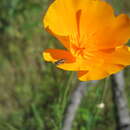en
names in breadcrumbs


Perdita is a large genus of small bees native to North America, particularly diverse in the desert regions of the United States and Mexico. There are over 600 currently recognized species of Perdita, plus more than 100 additional subspecies and many more species that remain undescribed.[1] Perdita are usually quite small (2.0 mm to 10.0 mm) and often brightly colored with metallic reflections and/or yellow or white markings, and among the few lineages of bees incapable of stinging. The genus was extensively treated by P.H. Timberlake who, in addition to T.D.A. Cockerell, described most of the known species. Most species are extreme specialists (oligoleges) with respect to pollen and will only collect pollen from a few closely related species or genera of plants. Many species in this genus are called fairy bees.[2]
They may be parasitized by Neolarra cuckoo bees, which lay eggs in their nests given the opportunity.[3]
Perdita is a large genus of small bees native to North America, particularly diverse in the desert regions of the United States and Mexico. There are over 600 currently recognized species of Perdita, plus more than 100 additional subspecies and many more species that remain undescribed. Perdita are usually quite small (2.0 mm to 10.0 mm) and often brightly colored with metallic reflections and/or yellow or white markings, and among the few lineages of bees incapable of stinging. The genus was extensively treated by P.H. Timberlake who, in addition to T.D.A. Cockerell, described most of the known species. Most species are extreme specialists (oligoleges) with respect to pollen and will only collect pollen from a few closely related species or genera of plants. Many species in this genus are called fairy bees.
They may be parasitized by Neolarra cuckoo bees, which lay eggs in their nests given the opportunity.